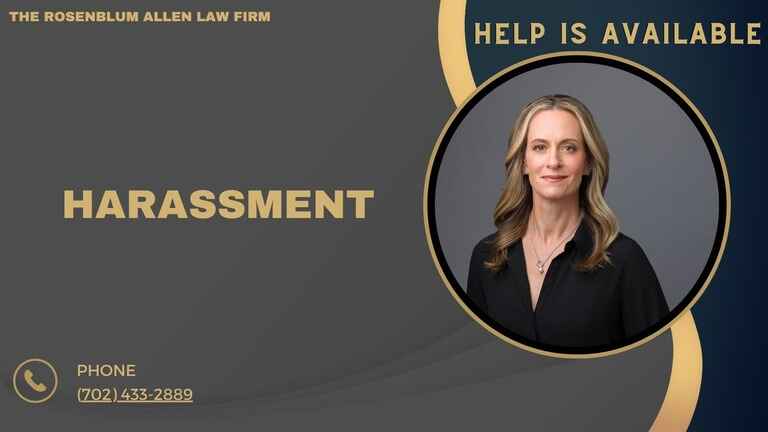What is Harassment?
Harassment is a form of unwanted behavior that can cause significant distress or harm to the victim. It can take many different forms, from verbal abuse to physical intimidation. Understanding what constitutes harassment is the first step in recognizing it and knowing how to take action.

Definition of Harassment
Harassment is any unwanted behavior or conduct that targets a person based on their characteristics, actions, or beliefs. This behavior typically occurs repeatedly, creating a hostile or unsafe environment for the victim. Harassment can be overt, like direct threats or insults, or subtle, such as exclusion or manipulation.
Types of Harassment
Harassment is not a one-size-fits-all issue. It can manifest in various ways, affecting the victim in different ways. Below are some common types of harassment:
Verbal Harassment
This includes harmful words or threats to belittle, humiliate, or provoke someone. It can be in the form of insults, name-calling, slurs, or verbal threats.
Physical Harassment
Physical harassment involves unwanted physical contact, such as hitting, pushing, or other forms of aggression. It can be aggressive or subtle, like blocking someone’s path or invading their personal space.
Emotional or Psychological Harassment
This type of harassment manipulates the victim emotionally, causing them to feel anxious, distressed, or psychologically unstable. It can include gaslighting, constant criticism, and isolation.
Online or Cyber Harassment
With the rise of the internet, harassment has expanded into the digital realm. This involves using social media, text messages, or emails to intimidate, threaten, or spread false information about someone.
Sexual Harassment
Sexual harassment includes any unwanted sexual advances, comments, or behaviors that create an uncomfortable or hostile environment. It can range from inappropriate jokes to physical contact.
Difference Between Harassment and Bullying
While harassment and bullying share some similarities, there are key differences. Bullying is often repetitive, and it generally involves a power imbalance, with the bully having more social, physical, or emotional power than the victim. Harassment can occur in various contexts and is often associated with protected characteristics like race, gender, or sexual orientation. The critical difference lies in the victim’s perception of harm or discomfort, whether the behavior is persistent, and the specific legal protections available.
Signs of Harassment
Recognizing harassment early on can prevent the situation from worsening. There are several signs to watch for that indicate harassment is taking place.
Recognizing Harassing Behavior
Harassment can look different depending on the context and type, but here are common signs that harassment may be occurring:
- Repeated Unwanted Contact: Persistent messages, calls, or attempts to interact, especially when asked to stop.
- Verbal Abuse and Threats: Insults, threats, or degrading comments directed at the victim.
- Intimidating Actions: Using body language, physical posture, or threatening gestures to make someone feel unsafe.
- Unwanted Physical Touch: Any form of physical contact that isn’t consented to, whether intentional or accidental.
Psychological Effects of Harassment
Harassment doesn’t only cause physical harm—it can have severe psychological effects. Victims often experience:
- Anxiety and Fear: The constant worry about encountering the harasser can lead to ongoing stress.
- Decreased Self-Esteem: Harassment can make victims feel worthless or inferior, primarily if the behavior attacks their identity.
- Emotional Distress: Feelings of sadness, helplessness, or confusion are common as victims try to cope with the harassment.
Harassment often leads to emotional and mental health struggles, such as depression or post-traumatic stress disorder (PTSD), especially when it goes on for an extended period.

Legal Protections Against Harassment
Victims of harassment are entitled to legal protections. Understanding these laws can help victims take action to stop the harassment and hold the responsible party accountable.
Harassment Laws in Nevada
Nevada has specific laws designed to protect individuals from harassment. These laws cover harassment in various contexts, including the workplace, public spaces, and personal relationships.
Nevada’s Anti-Harassment Statutes
Nevada has anti-harassment laws that prohibit various forms of harassment. These laws include protections for individuals facing harassment at work, in housing, or in any other area where harassment occurs. Victims can seek relief through civil action or criminal prosecution.
Harassment in the Workplace
Nevada law prohibits harassment in the workplace, particularly when it involves discrimination based on race, gender, sexual orientation, or other protected categories. Employers must take reasonable steps to prevent harassment and provide a way for employees to report it.
Federal Harassment Laws
Several laws designed to protect individuals from harassment, particularly in the workplace and in public accommodations, are also in place at the federal level.
Civil Rights Act of 1964
Title VII of the Civil Rights Act of 1964 makes it illegal to harass someone based on their race, color, religion, sex, or national origin. This includes both harassment in the workplace and harassment in public places or other services.
Protection Under the Fair Housing Act
The Fair Housing Act protects individuals from harassment related to housing. It prohibits discrimination based on race, color, religion, sex, disability, or familial status.
Education and Harassment Under Title IX
Title IX of the Education Amendments of 1972 protects individuals from sexual harassment and discrimination in educational settings. This applies to schools and universities that receive federal funding.
How the Law Defines Harassment
Legally, harassment occurs when an individual or group’s behavior creates a hostile, intimidating, or offensive environment for the victim. The law considers the severity and frequency of the behavior and whether the harasser intended to cause harm.
The Legal Threshold for Harassment
An act must meet specific criteria to be legally considered harassment. It must be repeated and pervasive and must create a hostile, intimidating, or offensive work environment or public space.
Understanding Intent vs. Impact
While the harasser’s intent is considered, the legal focus is often on the behavior’s impact on the victim. The victim’s experience and perception of the harassment are crucial in determining whether the actions violate harassment laws.
How to Report Harassment
If you believe you are a victim of harassment, taking action as soon as possible is essential. Reporting harassment can help stop it, hold the responsible party accountable, and protect others affected. Here’s a step-by-step guide on how to report harassment:
Steps to Report Harassment
- Document the Incident(s)
- Write down every detail of the harassment, including dates, times, locations, and what was said or done. Keeping a clear record helps build your case.
- Talk to the Harasser (If Safe to Do So)
- If you feel safe, try telling the harasser their behavior is unacceptable. Sometimes, people may not realize they are crossing a line. However, only approach them if you feel comfortable and safe doing so.
- Report to Your Employer or School
- If the harassment happens at work or school, report it to your supervisor, HR, or the appropriate authority. Many organizations have specific procedures for handling harassment complaints.
- File a Police Report
- If the harassment involves threats of violence, physical harm, or any illegal activity, file a police report. This is especially important for cases of criminal harassment, including stalking.
- Seek Legal Help
- If harassment continues despite your efforts or escalates, contact a lawyer. A lawyer can help you understand your legal rights and may assist in taking legal action against the harasser.
How to File a Complaint with the Equal Employment Opportunity Commission (EEOC)
If the harassment occurs in the workplace and is related to discrimination (based on race, sex, religion, etc.), you can file a complaint with the EEOC. The process involves:
- Filing the Complaint: File the complaint within 180 days of the incident.
- Investigation: The EEOC will investigate your complaint and decide whether the harassment violates federal law.
- Resolution: If the EEOC finds merit in your claim, it may offer a resolution or file a lawsuit.
How to Report Cyber Harassment
For cyber harassment, it’s essential to:
- Save Evidence: Take screenshots of harassing messages or posts. This evidence will help support your case.
- Report Harassment on Social Media: Most platforms have tools for reporting harassment. Use them to block the person and report their behavior.
- Contact Authorities: In severe cases like threats or stalking, you may need to involve the police.
Taking Legal Action Against Harassment
If the harassment continues or escalates, you may need legal action. Several legal avenues are available depending on the severity of the harassment and your specific circumstances.
Civil Lawsuits for Harassment
In many cases, harassment victims can file a civil lawsuit against the harasser. Civil lawsuits can seek compensation for damages caused by the harassment, including emotional distress, medical costs, lost wages, and more.
How to File a Civil Lawsuit for Harassment
To file a civil lawsuit, you’ll need to:
- Gather Evidence: Documentation of the harassment is crucial. This includes written accounts, photographs, witness statements, and any communications.
- Contact a Lawyer: A personal injury or harassment lawyer can help you understand your options and guide you through the process.
- File the Complaint: Your lawyer will help file the complaint with the appropriate court. The harasser will be served with the legal documents and required to respond.
Criminal Charges for Harassment
In some cases, harassment may involve criminal behavior, such as threats, stalking, or physical violence. If the harassment falls under criminal law, you may pursue criminal charges.
Types of Criminal Harassment
- Stalking: Repeatedly following or threatening someone.
- Threats of Violence: Making threats that can lead to harm.
- Assault: Physical harassment or contact that leads to harm.
How to Pursue Criminal Charges
To pursue criminal charges, contact the police and file a report. They will investigate the situation, and if sufficient evidence is found, the case may proceed to court. If the harasser is convicted, they could face fines, jail time, or other penalties.
Restraining Orders
A restraining order can offer protection if you feel your safety is at risk. A restraining order legally prevents the harasser from contacting or coming near you.
Types of Restraining Orders
- Temporary Restraining Orders (TROs): These short-term orders offer immediate protection until a hearing is held.
- Permanent Restraining Orders: A permanent order can be issued after a hearing, preventing the harasser from approaching or contacting the victim.
How to Obtain a Restraining Order
You can request a restraining order at your local courthouse. You must provide evidence of the harassment, and a judge will decide whether to grant the order.

How to Protect Yourself from Harassment
If you’re facing harassment, there are steps you can take to protect yourself and reduce the risk of further harm.
Stay Safe in Your Daily Life
- Change Your Contact Information: If you are harassed by someone over the phone, via email, or on social media, consider changing your contact information or blocking the person.
- Limit Personal Information Sharing: Be cautious about sharing personal details on social media or in public spaces that could make you a target.
- Surround Yourself with Support: Let friends, family, or coworkers know what’s happening. They can offer emotional support and help keep you safe.
Increase Your Digital Security
With the rise of cyber harassment, online safety is more important than ever.
- Use Strong Passwords: Ensure your online accounts are secured with strong, unique passwords to prevent unauthorized access.
- Enable Two-Factor Authentication: This extra step can make it harder for someone to access your accounts even if they know your password.
- Report Cyber Harassment: Use the reporting tools provided by social media and online platforms to block and report the harasser.
Stay Calm and Seek Support
Harassment can be emotionally draining. It’s essential to take care of your mental health during this time.
- Talk to a Therapist or Counselor: Professional support can help you cope with the emotional effects of harassment.
- Join Support Groups: Many communities have support groups for victims of harassment. These groups offer comfort, shared experiences, and guidance from others who have gone through similar experiences.
How Harassment Can Affect Your Life
Harassment doesn’t just cause emotional pain—it can affect almost every area of life, from work to personal relationships.
Impact on Mental and Physical Health
The stress and anxiety caused by harassment can take a toll on your mental and physical health. Victims may experience:
- Chronic Stress: Constant anxiety about facing the harasser can lead to physical symptoms like headaches, fatigue, or difficulty sleeping.
- Mental Health Struggles: Depression, anxiety disorders, or post-traumatic stress disorder (PTSD) are every day among victims of harassment.
- Isolation: Harassment can cause victims to withdraw from social activities, leading to loneliness and further emotional distress.
Effect on Work and Education
Harassment can also negatively impact your work or academic performance. The emotional toll of harassment can make it difficult to focus, leading to the following:
- Decline in Work Performance: Victims of workplace harassment may struggle with concentration, affecting their job performance.
- Absenteeism: Many victims take time off to avoid interactions with the harasser, which can affect their career or education.
- Career Advancement Issues: Harassment can hinder career growth, as victims may avoid seeking promotions or new job opportunities due to the toxic environment.

Breaking It Down for You
Harassment, in any form, can have a lasting impact on your life. Whether it occurs at work, school, or online, knowing how to report it and take steps to protect yourself is essential. By documenting incidents, reporting the behavior, and seeking legal assistance, you can stop the harassment and regain control of your life.
Remember, you don’t have to face harassment alone. Legal professionals, support groups, and resources are available to guide you through the process and ensure your rights are respected. Taking action early, gathering evidence, and utilizing the support systems around you can make all the difference.
By taking the proper steps, you can end harassment and regain your peace of mind. Your safety and well-being should always come first; resources are available to help you through this difficult time.

Frequently Asked Questions
What types of harassment are considered illegal?
Harassment can take many forms, but certain types are illegal under federal and state laws. These include sexual harassment, racial harassment, and harassment based on religion, gender, disability, or other protected characteristics. Workplace harassment, school bullying, and cyber harassment are some common examples of illegal harassment.
How can I prove harassment?
To prove harassment, it’s essential to keep detailed records of the incidents. This includes dates, times, locations, and descriptions of the behavior. Any witnesses or evidence, such as screenshots or recordings, can also help support your claim. The more evidence you can gather, the stronger your case will be.
What should I do if harassment happens online?
Online harassment, also known as cyberbullying, can be just as damaging as harassment in person. If you face online harassment, take screenshots or save any evidence of the messages, posts, or interactions. Report the harassment to the platform, and if necessary, contact law enforcement or a lawyer to explore legal options.
What are the legal consequences for someone who harasses others?
Harassment can result in civil and criminal penalties, depending on the nature and severity of the behavior. Civil penalties might include compensation for damages caused by emotional distress, while criminal penalties could involve fines, restraining orders, or even jail time for extreme cases.
Can I file a harassment lawsuit without involving the police?
Yes, you can file a civil lawsuit for harassment without involving the police. However, the police may be involved if the harassment crosses into criminal behavior, such as threats of violence or stalking. It’s often recommended to consult a lawyer to understand your best course of action and whether law enforcement should be notified.
What is a restraining order, and how can it help stop harassment?
A restraining order is a legal order issued by a court that prohibits someone from contacting or coming near you. If you’re facing harassment, a restraining order can provide immediate relief by legally preventing the harasser from approaching you. Violation of a restraining order can result in legal penalties for the harasser.
How long does it take to resolve a harassment case?
The time it takes to resolve a harassment case can vary widely depending on its complexity, the evidence available, and whether the case goes to trial. Some cases may be resolved through settlement or mediation, while others may take longer if they go through the court system.
Can I get compensation for the emotional distress caused by harassment?
Yes, it is possible to receive compensation for emotional distress caused by harassment. If you can prove that the harassment significantly impacted your emotional well-being, you may be able to recover damages in a civil lawsuit. The amount will depend on the severity of the harassment and its effect on your life.
What should I do if the harassment continues despite reporting it?
If the harassment continues despite reporting it, you may want to escalate it. This could involve seeking legal help, such as filing a lawsuit or obtaining a restraining order. Depending on the situation, you can also report the behavior to higher authorities, such as an employer’s HR department or relevant governmental bodies.
What should I expect during the legal process for a harassment case?
During a harassment case, you can expect to go through several stages, including gathering evidence, filing legal documents, possibly attending hearings or mediation sessions, and potentially going to court. Your lawyer will guide you through the process, ensuring that your rights are protected every step of the way.

Glossary
Harassment: Unwanted or aggressive behavior that causes distress or harm to another person. It can be physical, verbal, or emotional and can occur in various settings, such as the workplace, school, or online.
Sexual Harassment: A form of harassment that involves unwanted sexual advances, comments, or behavior. It can include physical touch, verbal comments, or the display of inappropriate materials.
Racial Harassment: Harassment based on a person’s race or ethnicity. This type of harassment can include offensive comments, jokes, or discriminatory actions directed at someone because of their racial or ethnic background.
Cyberbullying: A form of harassment that takes place online, through social media, emails, or other digital platforms. It can involve threats, spreading rumors, or sharing hurtful content about someone.
Workplace Harassment: Harassment that occurs in a professional environment. It can include bullying, discrimination, or other inappropriate behaviors directed at an employee or colleague.
Stalking: A form of harassment that involves repetitive and obsessive behavior towards someone, often involving following or monitoring the person’s movements or actions. Stalking can be physical or online.
Evidence: Information, documents, or testimony used to support a claim or argument in a legal case. In harassment cases, evidence might include emails, text messages, photos, or witness statements.
Restraining Order: A legal order issued by a court that prohibits someone from contacting or coming near another person. It’s often used in cases of harassment or stalking to protect the victim from further harm.
Civil Lawsuit: A legal case filed in court in which one party seeks to claim damages or compensation from another party for a perceived wrong, such as harassment or emotional distress.
Criminal Penalties: Legal consequences for a crime, which may include fines, imprisonment, or other legal actions. Criminal penalties for harassment can apply when the behavior is severe enough to be considered a criminal offense.
Emotional Distress: Psychological harm caused by another person’s actions, such as harassment. It can lead to anxiety, depression, or other emotional and mental health issues. Victims of harassment may seek compensation for emotional distress in a civil lawsuit.
Mediation: A process in which a neutral third party helps two sides reach a resolution without going to trial. In harassment cases, mediation can be a way to resolve the dispute outside of court.
Complaint: A formal statement filed with authorities or an organization, such as a workplace or school, to report harassment. It outlines the nature of the harassment and requests a resolution.
Settlement: An agreement reached between the parties involved in a dispute, often before a trial takes place. In harassment cases, a settlement may involve compensation for the victim or changes in behavior or workplace policies.
Witness: A person who has seen or heard an event related to a legal case, including harassment. Witnesses can provide statements or testimony that support a harassment claim.
Damages: Monetary compensation awarded to a victim in a lawsuit to cover losses or harm suffered due to someone else’s actions. In harassment cases, damages may include compensation for emotional distress or lost wages.
Legal Representation: A lawyer or attorney who provides advice and guidance to someone pursuing legal action. Legal representation is crucial for navigating harassment claims and protecting your rights in court.
Public Records: Documents or information that are legally available to the public, often held by government agencies. Some harassment cases may involve public records if the case is part of a court proceeding.
Legal Recourse: The legal means available for a person to seek compensation or justice after experiencing harm, such as filing a lawsuit or requesting a restraining order.
Burden of Proof: The responsibility of a party in a legal case to provide evidence that supports their claims. In harassment cases, the victim has the burden of proof to show that the harassment occurred.
Compensation: Money awarded to a person as reimbursement for loss or injury. In harassment cases, compensation may be given for physical, emotional, or financial damages caused by the harassment.

Additional Resources for You
Molly Rosenblum, Esq., our lead attorney, has not only showcased her legal acumen in courtrooms but also extended her experience through a variety of resources tailored to support those facing criminal charges. These resources, carefully developed and available on the Rosenblum Law website, are designed to provide crucial information and guidance across a broad spectrum of criminal defense areas. Here’s a summary of the resources you can access to navigate through challenging times:
Criminal Defense Attorneys: A comprehensive overview of criminal defense services offered, highlighting the firm’s expertise and commitment to defending your rights. Explore the resource.
Las Vegas DUI Lawyer: Specialized guidance for those facing DUI charges in Las Vegas, offering strategies for defense and information on navigating the legal system. Learn more.
Domestic Violence Lawyer Las Vegas: Expert legal advice and representation for individuals accused of domestic violence, emphasizing defense strategies and rights protection. Discover the details.
Drug Possession Lawyer: Insights into defending drug possession charges, with information on legal nuances and defense approaches. Start your defense.
Sex Crimes Attorney: Dedicated resources for those accused of sex crimes, focusing on defense strategies, legal implications, and rights protection. Understand your options.
CPS Defense Attorney: Assistance for those facing Child Protective Services (CPS) investigations or accusations of child abuse and neglect. Get informed.
Misdemeanor Lawyer: Guidance on handling misdemeanor charges, emphasizing the potential impacts and defense strategies. Learn about misdemeanor defense.
Juvenile Defense Lawyers: Specialized defense services for juveniles facing criminal charges, focusing on the unique aspects of juvenile law. Explore juvenile defense.
Las Vegas Warrant Defense Attorney: Advice on addressing arrest warrants in Las Vegas, with strategies for resolving outstanding warrants and minimizing legal consequences. Address your warrant.
Las Vegas Probation Violation Attorney: Expertise in handling probation violation accusations, offering defense strategies to avoid severe penalties. Navigate probation issues.
Theft Crime Defense Lawyer: Defense strategies and legal advice for those accused of theft crimes, focusing on protecting your rights and minimizing consequences. Defend against theft charges.
Kidnapping Lawyers: Specialized legal representation for kidnapping charges, with a focus on defense tactics and mitigating legal repercussions. Understand kidnapping defense.
Firearms Lawyer Las Vegas: Legal guidance for issues related to firearms laws in Las Vegas, including charges of unlawful possession or use. Learn about firearms law.
Through these resources, Molly Rosenblum, Esq., aims to empower you with the necessary information and support to face criminal charges with confidence. Each resource is crafted to help you understand your legal situation and to provide a foundation for your defense strategy. We encourage you to utilize these resources as you navigate through the complexities of the criminal justice system.

Offsite Resources for You
Here are some offsite resources that you may find useful:
American Bar Association – Criminal Justice Section: This section of the ABA provides valuable information about various aspects of criminal justice.
National Association of Criminal Defense Lawyers: NACDL is the preeminent organization advancing the mission of the criminal defense bar to ensure justice and due process.
U.S. Department of Justice – Office of Juvenile Justice and Delinquency Prevention: The OJJDP provides comprehensive information on juvenile justice issues and includes numerous links to publications and other resources.
The National Trial Lawyers – Top 100: An invitation-only organization composed of the premier trial lawyers from each state or region who meet stringent qualifications.
Nevada Revised Statutes: This is a comprehensive list of all the laws in the state of Nevada, including those pertaining to criminal offenses.
National Institute on Drug Abuse: NIDA’s mission is to lead the nation in bringing the power of science to bear on drug abuse and addiction. It offers resources related to drug abuse and a directory of drug abuse treatment programs.

A Special Message from Our Lead Attorney

Molly Rosenblum
Dear Reader,
Thank you for taking the time to review our Harassment Charges resources. We understand that facing such charges can be a challenging and stressful time.
At The Rosenblum Allen Law Firm, we want you to know you’re not alone in this process.
My name is Molly Rosenblum, and as the lead attorney here, I want to invite you to contact us.
We’re here to help you understand your legal options, rights, and the potential defenses that may be available.
Please schedule a free consultation with us to discuss your case in detail. You can reach us by calling (702) 433-2889.
We’re here to listen, understand, and provide your legal support.
Remember, every conversation with us is confidential, and this initial consultation is entirely free of charge.
We look forward to the opportunity to assist you.
Warm Regards,
Molly Rosenblum, Esq.



